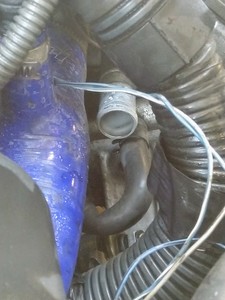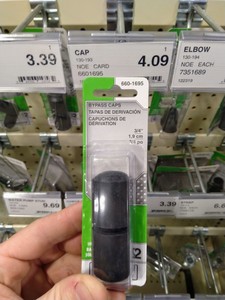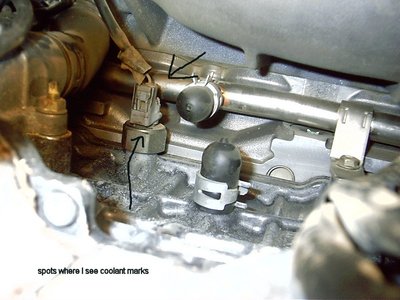Recently, I got stranded on the side of the highway after my 2ZZ blew the large coolant cap right off the engine, during or immediately after some high rpm driving. This is the second time this has happened to me.
Backstory:
When I first got the car swapped and running, I filled and bled the coolant system as I had read to do. Rear raised and reservoir open, purge valves open, heater system in car also open. It went well enough, but over the course of the next few days after getting on the road I still found myself adding a little coolant. Eventually this stopped and system stabilized.
A month later, during or immediately after some hard pulls, I blew off the large coolant cap. I chalked it up to being a noob, I rationalized I had probably left some air in the system and this caused an excess of pressure to blow the cap off (more on this later). I bought some more coolant and a new cap...
Tangent and PSA: Do not pay SuckeyWrench $5-$8 a piece +shipping for these caps. They are called Bypass Caps and you can find them at your local auto parts store for a fraction of the cost. Got mine at Napa:
Back on track:
I toyed with the idea of clamping the cap to "prevent" this issue from repeating itself, but opted not to out of fear of blowing one of the other two, harder to reach, caps if there was a "next time." If I was to blow a coolant cap, I'd rather it be the most accessible one. I installed the new cap, with no clamp and refilled the coolant system, same as before, but over a period of several days before I put the car back on the road. I think I topped off once after the first drive, I felt much more confident in getting all the air out this time. I threw the extra bypass cap in the glovebox just in case.
Fast forward 22 months:
Same scenario, same cap blew. Coolant system had been closed and stable for the past 22 months. WTF? Luckily, past me had thrown that extra cap in the glovebox, so it was on hand (thanks, past me). I was also about a mile from the nearest convenience store, I won't call that lucky, since it was uphill both directions, in the snow, but it could've been worse. The store only had crappy universal coolant, so I opted to just buy two gallons of distilled water to get me home. After a long hike and a quick and dirty "coolant fill" I got home.
Then I started thinking, why would this happen again after so long? Potential culprits:
Minor leak somewhere? Water pump? No visible leaks anywhere, or red crystals.
Thermostat? I would suspect that problem would be more prevalent if the thermostat was malfunctioning.
Head gasket? No visible signs of failure on the engine, in cooling or oiling system.
Which left me with.... Reservoir cap. Maybe it wasn't releasing pressure as it should. Unfortunately I could not find a cap tester in the parts store rental kits that allowed me to pressure test my OEM cap, so I opted to buy an $8 aftermarket cap to do some "real life" testing with. Back at home, I pushed the release valve with a small screwdriver on both caps. The OEM did not appear to travel as far as the aftermarket. Maybe I was on to something.
WARNING! The next steps are hazardous! I do not condone or accept liability of anyone else opening a coolant system at operating temp. If anyone does do this, use EXTREME caution:
After getting the coolant system full and bled, I let the engine get to operating temp with the new cap on, then opened the cap until it broke the seal. A moderate hiss was heard and the coolant level in the reservoir went up about 1.5". I let the engine go cold again and did the same test with the old OEM cap. Before opening, I observed the coolant level was lower than with the new cap. Upon opening the cap a large volume of air blew out and coolant level in reservoir raised nearly 4" back to the same level it had with the new cap.
I took this as my answer. My old reservoir cap was not venting pressure to the specified 108kPa and the result was occasionally blowing off a bypass cap. My prior thought process of too much pressure was partially correct, there was indeed too much pressure. The incorrect part was thinking the pressure was due to an air pocket in the coolant system. The reservoir cap should have vented pressure down and maintained only 108kPa in the coolant system regardless of how much unwanted air was present.
TL:DR, make sure your reservoir cap vents properly. If it is more than a decade old, wouldn't hurt to replace it.
Interesting discussion where I have something to add.
You are not the first to report that bypass cap blowing out. The reason for this is that alternative replacements are not as good as the OEM Toyota. Apparently the rubber gets weakened and can easily slip off in time. Nobody had a problem with the OEM but it was found out that Suckywrench was selling the OEM which was reported to be blowing out as well. Because they were caught advertising for OEM and then doing a bate and switch with third party crap its possible they were not OEM either. At the time it was suspected that maybe the OEM changed the quality of the cap but I do not think that is the case as I remember that the ones that were actually purchased at the dealer had no issues.
The procedure you describe of loosening the cap to clear out the bubble is what I have coined "the trick". It works when you are in a pinch but you need to be carful. It will clear out the bubble.
The best way to avoid any future bubbles is to over fill the coolant. It is the actual position of the 2ZZ engine coolant jackets that is creating the issue so adding more coolant can actually offset this issue to filter out bubbles so they do not get sucked back into the system.
Odd, I have searched before, and again now, and do not find any documentation of this issue... Besides my own unanswered post on AdChat from the first time this happened. My first cap came from SuckeyWrench, the next one I lost was a Napa cap.
I have kept my coolant overfilled since the first time this happened. About an inch over the seam in the reservoir when cold.
I guess in another two years I'll learn if my reservoir cap was the culprit or if the problem is inherent to lower quality bypass caps. Next time I have the drivetrain removed I may just clamp all three caps for peace of mind.
Odd, I have searched before, and again now, and do not find any documentation of this issue... Besides my own unanswered post on AdChat from the first time this happened. My first cap came from SuckeyWrench, the next one I lost was a Napa cap.
I have kept my coolant overfilled since the first time this happened. About an inch over the seam in the reservoir when cold.
I guess in another two years I'll learn if my reservoir cap was the culprit or if the problem is inherent to lower quality bypass caps. Next time I have the drivetrain removed I may just clamp all three caps for peace of mind.
The search is broken over there and I suspect many missing threads since im having a hard time finding old discussions.
It was discussed in length and one person was able to remove the metal tube and cap off the opening using some sort of freeze plug.
I took the position of advising to get the original from the dealer and replacing it which someone did and I suppose it held. Toyota stuff might look similar to something else but there are some hidden details like the rubber composition and reinforcement that makes all the difference in the world. I remember those that were buying the silicone vacuums line crap which ended up collapsing on people or forming tears at the openings causing vacuums leaks. The silicone was suppose to be superior over the OEM but now its laughable. I have the original bypass plug on my car and its going strong and generally not an issue with most of the swaps out there.
Every hose connection, including any rubber caps, must be secured with a proper hose clamp. The system pressure is too great to be held without a clamp. Of course the cap blew after running at high power! This will keep on happening until you install proper clamps
Dave
I'm not saying you are wrong, but with that in mind, I'd like to point out how all of the coolant caps on the stock 1zz I pulled out of my car had no clamps of any kind on them. I took mental note of this last year when I was scavenging useful bits from that engine before sending it to the scrapyard.
I'm not saying you are wrong, but with that in mind, I'd like to point out how all of the coolant caps on the stock 1zz I pulled out of my car had no clamps of any kind on them. I took mental note of this last year when I was scavenging useful bits from that engine before sending it to the scrapyard.
Mine has a clamp.
What I would do is get the OE bypass cap which is reinforced rubber. Then buy a brand new clamp. The clamp is one of the wide spring clamps. I think the reason why a few had this problem is reusing the old clamp and not using the OE rubber.
I also don't think one of the cheap small radiator clamps would work. The Toyota clamp is substantial and the reason why it holds on tight under pressure.
@marsrock7 I can guarantee any caps on any production car will have clamps fitted at the factory
I stand corrected. I guess someone monkeyed with the 1zz that came with my car. Will have to see if I am able to reach all three locations to add clamps to the caps. Otherwise, I'll just wait till the drivetrain is out. If I have to risk blowing a cap, I still prefer to have the easily accessible one blow.
@marsrock7 Stay away from high power levels until you get it fixed. The system presssure will generally be proportional to power.
I've never had any issue with my 2zz swap. This post does concern me slightly. However, I have recently pulled my frunk plastics and noticed that the radiator had very minor seepage. Whether long term or new, I'm thinking I will need to replace this OE radiator. What brand do I get and from where?
I've never had any issue with my 2zz swap. This post does concern me slightly. However, I have recently pulled my frunk plastics and noticed that the radiator had very minor seepage. Whether long term or new, I'm thinking I will need to replace this OE radiator. What brand do I get and from where?
Stick with the OE radiator. The aftermarket can be a miss with leaks and odd bleeders which people had issues with.
The OE is built well because it’s Toyota and it lasts a long time. If it were me I would find a low mileage used one that usually has a guaranty and never worry about it.
Denso is always a solid choice.
2000 Toyota MR2 Spyder, 2021 Lexus UX 250h F Sport
I do not believe there is a Denso radiator available for this car. Denso is OE for Honda and Acura. Koyorad A2358 I believe is the OE. The R2358 is the aluminum version. Thanks SC. Finding a used OE is a little dangerous. I could get new OE at $280. Or a decent brand for under half that. Finding the good reliable brand that fits is what I'm ISO.
I'm also ISO the vented cowl cover (plastic below windshield surrounding the wipers).
Thanks peoples.



